Challenges and Strategies to Promote Innovation in Organizations: Insights from Global Leaders at GTC NVIDIA 2024
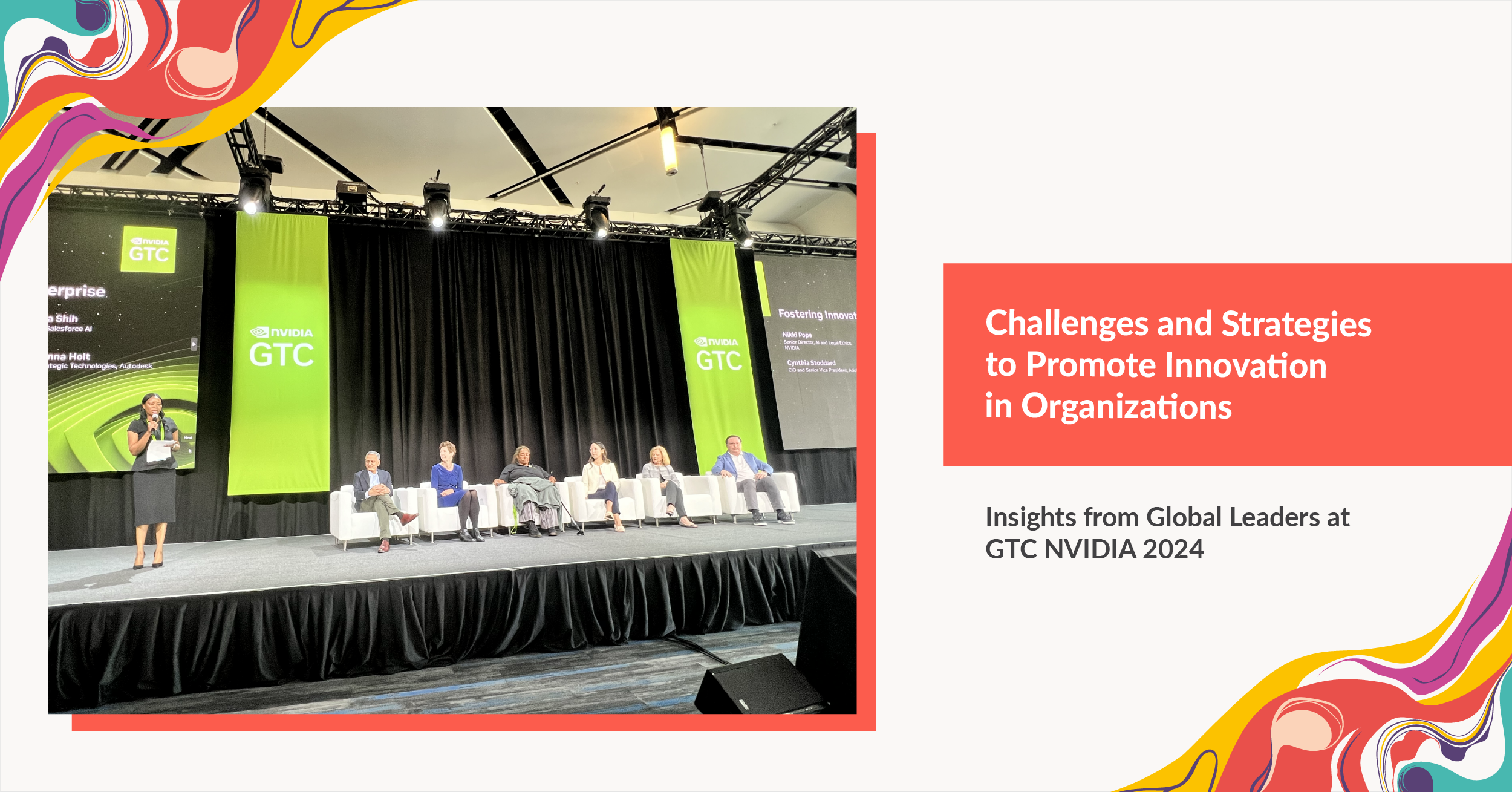
The stage at Nvidia’s global conference (GTC2024) was the ideal setting for an in-depth and inspiring discussion on the challenges and strategies for promoting innovation in organizations. One of the panels brought together renowned experts, who shared their views on how to deal with legacy systems, internal resistance and technical debts, elements often present on the road to innovation.
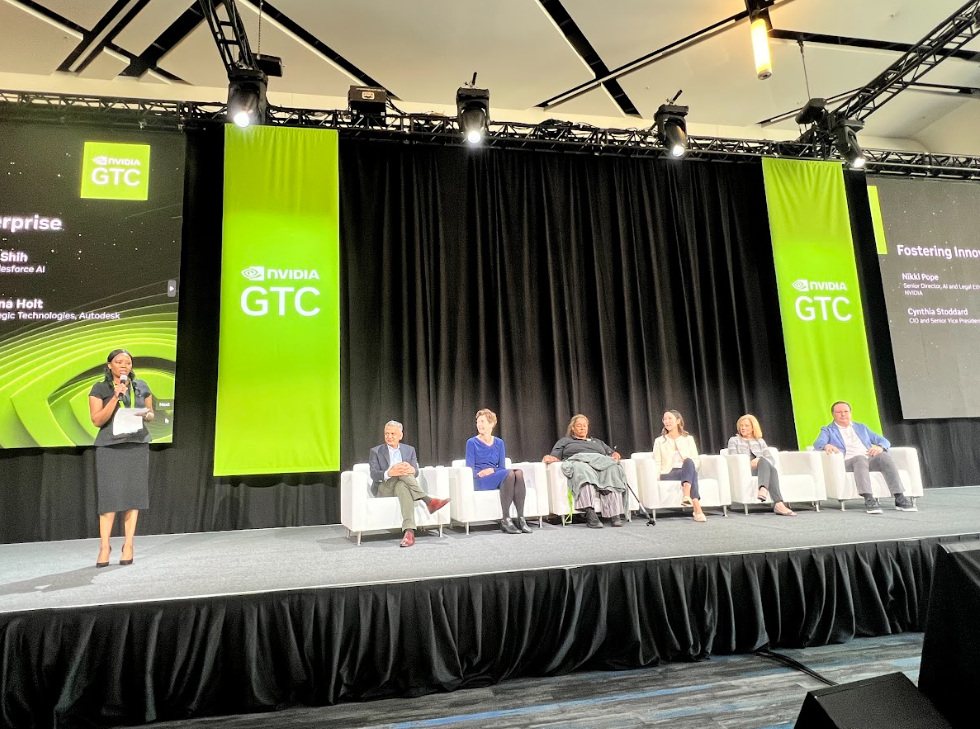
Rohit Chauan, VP of Mastercard, believes that we are facing a transformation as big as the internet itself and that all leaders must frame their projects with a view to taking advantage of the main capabilities of the new technologies.
In the case of the Internet, for example, the cost of communication and connection tends to zero. At that time, all the companies that managed to look at their challenges and projects through the lens of zero-cost communication came out ahead. And this created a series of opportunities in all aspects of the business, such as online stores, service applications, etc.
Today, the cost of creating forecasts and what-if scenarios is tending towards zero. So every leader should look at their challenges through the lens of simulation and prediction. “What can we do differently, now that we have this incredible simulation machine in our hands?” should be the question every leader should ask themselves.
Adobe’s Cynthia Stoddard adds that a large part of the leader’s role in this context is to point out problems or opportunities. Asking the right questions, stimulating debate and fostering a safe environment for innovation. It is also necessary to create a culture where a certain level of failure or trial and error is acceptable and to prepare corporate structures to take advantage of AI.
Cynthia says that Adobe created a unified source of data to make this information available to all the teams and managed to get them all to share their databases. But all this is only possible with effective Change Management so that people understand what they stand to gain from it.
Clara Shi, CEO at Salesforce AI, says that the nature of innovation is changing and that in the future you may not really need to rewrite software for innovation, but this will only happen if data is accessible and collaboration is encouraged.
According to her, companies have always lived in the world of structured data and today we have the possibility of using unstructured data. This means that if we overcome the integration challenges, we can put around 80% more data in people’s hands.
How do you get people on board?
Alex Balazs, VP at Intuit, believes that the biggest challenge in a traditional organization is to create the trust and corporate structure needed to innovate. After all, large organizations don’t tend to look kindly on mistakes and usually don’t have adequate incentives to stimulate innovation. That’s why he feels that more than looking outwards, it’s necessary to look inwards and organize a system of success metrics, incentives and leadership that encourage innovation.
Susanna Holt, VP at Autodesk, sees that the process requires a delicate balance, where value and empathy for current solutions are exercised, but at the same time people are encouraged to engage in building something new. That’s why, whenever possible, he tries to encourage projects between new and old teams, so that everyone is connected to the same mission.

Cynthia adds that another important point is to educate teams, both formally (with courses and objectives) and informally, simply by opening up space for people to interact with these tools and experiment freely.
Rohit points out that a big problem is that a large part of Enterprise companies’ revenue comes from legacy technologies, which still work well and are too robust to be reworked with new approaches. So a lot of the effort comes from integrating legacy stacks with new technologies to generate value.
Susanna adds that another challenge is human, as people working on legacy systems can feel demotivated and want to abandon core systems that are essential to companies. It is essential to create a sense of positive evolution and not something that discards or simply replaces the good work being done. In this sense, it is essential to have good communication, where the purpose of the change, the path, the advantages and the importance of this team in the context are made clear.
Alex goes on to talk about the human aspect of making the most of the talent working on legacy systems, training and motivating them so that they – who know them like no one else – can train themselves to evolve or revolutionize these systems.
This scenario requires ambidextrous leadership. We need to value the systems that work, understand what needs to be adjusted and what will be disrupted, and work as one team, with different missions and objectives for each part of the technology stack.
All the leaders reinforced challenges that are very familiar to many large organizations: incentive structures, a culture of innovation, prepared leaders and secure access to the data and technologies needed to innovate.
At the end of this panel, as well as practically all the others at the event, we were left with the clear feeling that we are living in very exciting and challenging times, and that traditional or innovative companies, large or small, must not miss the opportunity to rethink their business now in the face of these new possibilities.
Technology and Creativity: Advances and Perspectives in Artificial Intelligence

During the Nvidia 2024 global conference, a fascinating talk addressed the intersection between artificial intelligence and human creativity. Using the example of Getty Images, it discussed how the company developed its own Generative AI, based on Nvidia’s Picasso solution, to generate images with guaranteed copyright and fair remuneration for creators.
In the talk, Andrea Gagliano, Senior Director, AI/ML at Getty Images, talked about how the platform continuously remunerates photographers for the photos used in the tool’s training, in order to encourage the creative industry to continue producing material. Andrea commented that, even with an image bank that represents only a fraction of what other market solutions such as Midjourney use, they have used all of Getty’s experience to create a platform that delivers superior results for commercial uses.
Getty’s Generative AI has also been developed much more intentionally than others, in order to more fairly represent society and bring more natural, higher quality results. So when you create a prompt about a doctor in Getty’s AI, you get results with less bias than in other tools. And when you input something like fathers changing diapers, you get more natural, non-fantastical results.
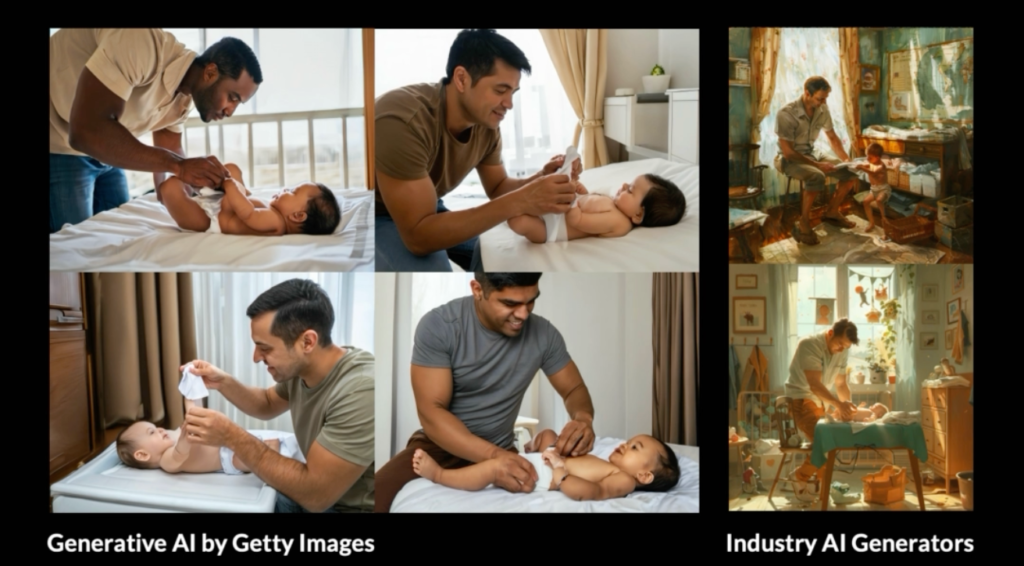
Andrea also stresses that the decision to pay the people responsible for the data used in training should also be seen as a question of the sustainability of databases for creative training. After all, if there isn’t enough data for the model to evolve, it will become increasingly incorrect.
As an example, she brought up the prompt of four generations coming together, which may become increasingly common in the future, with people living to be close to 100 years old. Today, there are still not enough images of this scene for the model to understand the demand. And this prevents it from responding efficiently. In other words, if creatives stop reflecting the world and recording social changes in large volume, the models will become stagnant.

GenIA can’t create images of four-generation families because there isn’t enough data
To reinforce her point, Andrea draws an interesting parallel between the evolution of the most searched images on Getty Images over the last few decades, showing how visual records reflect social changes. According to Andrea, when we think about remunerating creators, we’re not just thinking about them or the market as it was, but about the future and the very sustainability of Generative AI models.
Transformers and AI: panel with the pioneers of today’s AI.

The informal panel brought together, for the first time on the same stage, the inventors of the Transformer model, the architecture that made tools like Chat GPT possible.
We were able to follow the story behind the creation as told by the pioneers of the invention, from when the idea arose to solve problems of search speed and translation on Google to curiosities such as the model’s almost unfriendly name of CargoNET.
Jensen Huang, CEO at Nvidia, stressed the importance of the model for the evolution of Artificial Intelligence and stimulated debate on the next frontiers for the evolution of models. They commented on how the next step will probably be to have something capable of recognizing the size of the challenge and using the necessary computing power in order to make AI more efficient.
Today, for example, a 2+2 question can trigger a 1 trillion parameter model, which wouldn’t be necessary if the model could recognize the size of the challenge and trigger the appropriate computing power for it.
There has been a lot of talk about how, in the future, a new model could be created that uses less data and less computing power to arrive at even better and more sustainable results.

At the end of the panel, the speakers briefly introduced the companies they are helping to build today:
- Essential.Ai: A company that is working to build models that can observe humans, learn and operate just as efficiently.
- Character.ai: Platform for creating and interacting with AI-based avatars.
- Inceptive: A biological software company using AI to develop new medications and treatments.
- Sakana.AI: Research company for new models inspired by nature
- Cohere: a language model designed for enterprises.
- NEAR: Blockchain protocol for programmable money.
In a day marked by innovative insights and revolutionary perspectives, these talks illuminated the intersection between artificial intelligence and human creativity, pointing to a future in which technology not only reflects, but positively shapes society.
We are facing a crucial moment in the evolution of AI, where collaboration between humans and machines promises to radically transform the way we interact with the world around us.
Artificial intelligence, creativity and a very restless 100 trillion dollars

Check out the highlights of GTC 2024, Nvidia’s global conference, in a series of three exclusive pieces of content that our CEO, Pedro Braga, has developed for our customers and collaborators.
Nvidia’s GTC used to be a developers’ conference. It used to be, because the 2024 edition has become the biggest event San Francisco (CA) has seen in recent years, with dramatic and pyrotechnic launches that promise to further expand the horizons, possibilities and applications of Artificial Intelligence.
Over the last few days, we’ve closely followed everything we can understand about one of the major players in this revolution, which has shaken up the technology market and impacts on practically every industry.
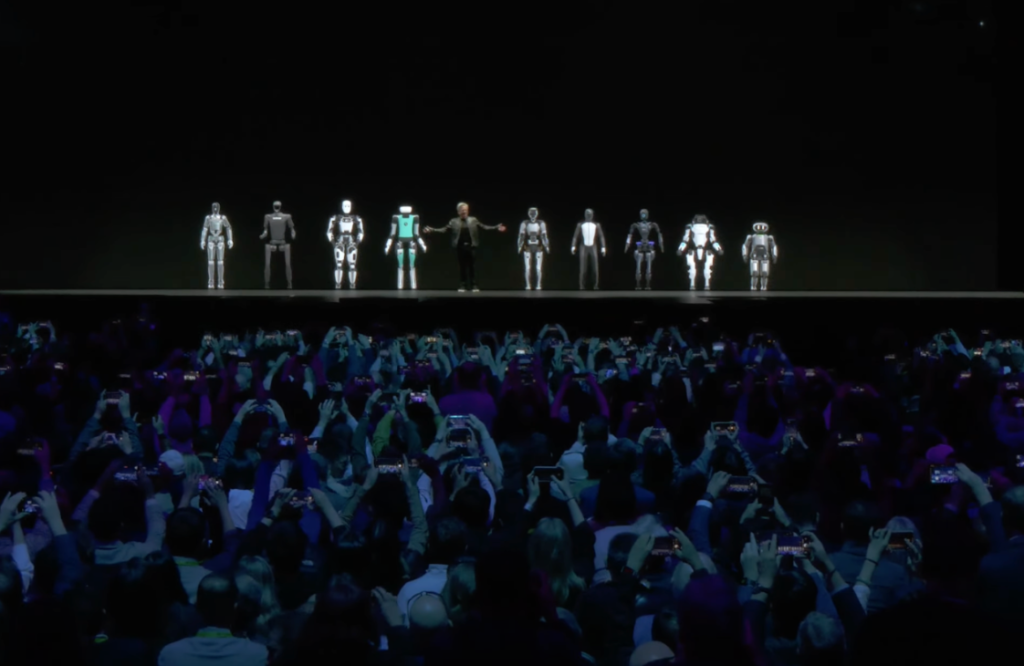
Opening keynote with Jensen Huang, CEO at Nvidia: Artificial intelligence and the 100+ trillion-dollar revolution
100T USD is the estimated size of the technology market in a few months. Obviously, this will be the market most impacted by the Artificial Intelligence revolution, but Jensen Huang, CEO at Nvidia, made it clear in his opening speech that we are facing a revolution that will transform the relationship between humans and technology, and not just the technology industry.
Jensen compared this moment to the introduction of electricity into human routines, with the same breadth of uses and impacts.
AI capable of learning anything and understanding everything.
According to him, we are facing a technological revolution that will soon allow us to capture, understand, create and redesign practically every aspect of the human experience digitally. Everything that can be digitized (including proteins, DNA, RNA, brain waves) can be understood, parameterized and used as the basis for simulations and new creations.
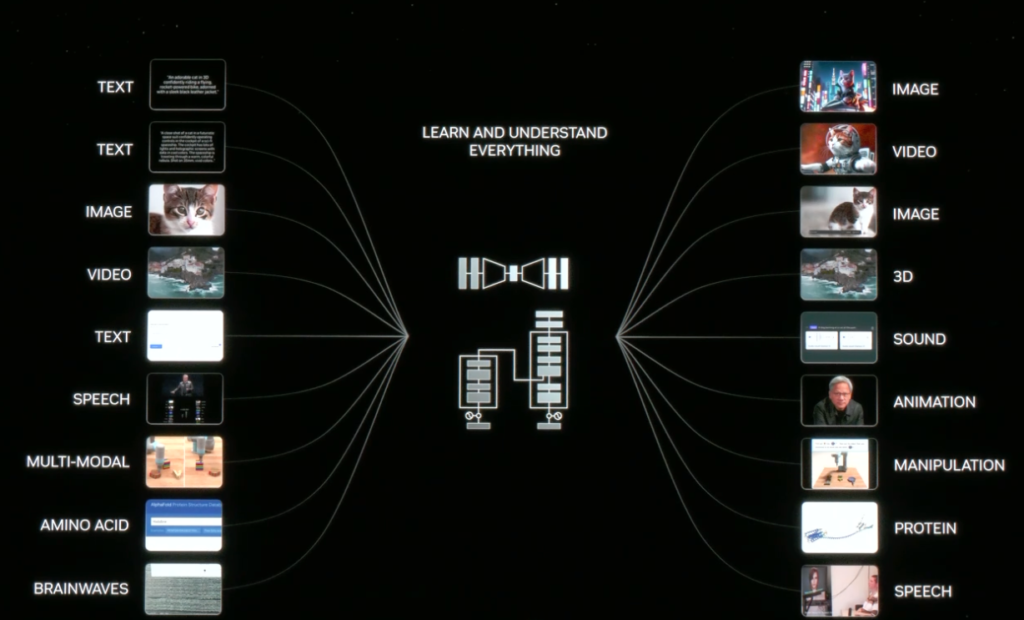
A new chip, more partnerships and many applications
Jensen announced strategic partnerships with major companies such as Microsoft and Siemens, launched a new Blackwell chip with expanded processing capacity and brought some impressive emerging applications of the new technologies.
The applications demonstrated ranged from designing new medical solutions, predicting extreme weather events, digital art, the accelerated use of digital twins and Project Groot, a complete platform for creating and training humanoid robots, capable of learning just by observing human beings.


Brad Lightcap, COO at Open AI, is called Sam Altman’s secret weapon and has been a key player in the company’s development. During the conversation, Brad explored the rapid evolution of Open AI and how solutions such as Chat GPT are being adopted by companies in different sectors.
As soon as the solution gained traction, large companies looked to Open AI to quickly implement the innovation in some way. The internal team said they were more like therapists than salespeople, given the number of corporate challenges they heard from each customer. But this does not seem to be the shortest route to extracting value from innovation and Brad shared some interesting tips.
How to extract value from Chat GPT and other innovative solutions
A good practice, according to Brad, is to start with a small application, designed to solve a specific part of the workflow. This approach will allow you to create a real, scalable use case. Often, cutting an hour or two off the financial analysis that a large team does every day can have a big impact on the organization.
Another good practice is not to limit your ambitions. Even if you start with a limited application, the vision should be broad. If you’ve started using AI to compare spreadsheets, you can now explore prompts to generate automatic insights from the data or create graphs, for example.
The third valuable tip is to broaden your contact with technology. Brad says that many companies have discovered many new uses for Chat GPT once teams have understood the possibilities and started testing solutions to their own problems.
After all, there’s no one better than the user to understand where to apply a technology with so many possibilities.
According to Brad, Open AI doesn’t plan to create solutions for specific use, but to focus its efforts on enabling companies to do so:
“Every time we think about creating something for a specific use, we remember that somewhere in the world there is someone who cares more about that problem than we do. That’s why we’re focused on evolving our model. Chat GPT itself is just one way of accessing them.”
As for how big language models really need to be, Brad says there’s room for everyone. According to him, just as you don’t use a hundred doctors to solve a simple task, it might not make sense to use one big state-of-the-art model for everything.
As for the next few years, Brad says he can’t say much, but someone born today will certainly have an absolutely different relationship with technology than we do. Basic things like graphical interfaces, files that need to be found in folders and e-mails will no longer make any sense.
The whole logic of “filing, recording and retrieving” ready-made, static information will be replaced by a more generative approach, where information is built up instantly, based on the use required at any given moment. This is a fundamental change in the way we interact with technology, which should greatly broaden our horizons and generate infinite possibilities.
Executive panel with technology leaders | Driving Enterprise Transformation
In this panel, the CIOs and VPs of LinkedIn, ServiceNow, Nvidia and SentinelOne gave real examples of how they are using AI to transform their businesses, what the challenges and opportunities are.
Sabry Tozin, LinkedIn’s VP of Engineering, revealed that one of the first use cases of the technology was to optimize the time of technical teams, who began to automate code migration and maintenance tasks in an unprecedented way. Since then, the team hasn’t stopped innovating.
Today, GenIA allows LinkedIn’s Customer Service to be handled in any language by professionals from anywhere, with real-time translation. This allows the company, for example, to focus on training the best specialists on the platform without worrying about languages or where they live.
Chris Bedi, CIO at ServiceNow, says that they have been working like never before to integrate AI into absolutely every product and workflow. According to him, ServiceNow has been working with two two-speed horizons for AI. In the first, they urgently analyze how current processes can be made more efficient or better using AI capabilities. In the second, they reinvent processes in an agile way to create a vision of AI First processes, with deeper transformations over a two- to three-year horizon.
In just 4 months of this approach and official internal use, ServiceNow has created more than 20 use cases and increased the productivity of general workflows by 10%, the productivity of customer-related activities by 14% and that of development teams by 5%. Today, ServiceNow’s AI already represents the work of 50 people and generates more than 10 million dollars in benefits.
Sandy Venugopal, CIO at SentinelOne, says that AI has made it possible to identify, evaluate and classify usage anomalies in order to identify cybersecurity risks faster and more efficiently than ever before. They are currently looking at all internal processes and their stages to understand which could be fully or partially automated with AI.
How to engage teams and accelerate the creation of AI solutions
Sandy comments that it is essential to create a team of curious enthusiasts (champions) and arm them with the necessary platforms and access to explore the possibilities, make mistakes in secure environments and start finding solutions through AI.
Sabry, from LinkedIn, points out that another important point for accelerating adoption and generating value is to have a good balance between what is developed in-house and connections with the ecosystem (open innovation).
According to him, a good practice when deciding what to buy and what to create in-house is to assess whether the challenge is peculiar to your business or could be common to other companies. If it is a broad challenge, it is very likely that there is already an advanced solution for it and the focus should be on finding and integrating it.
Ramma Akiraju, VP, Enterprise AI and Automation at Nvidia, believes that an important point is to create a very strong sense of purpose when deciding how to organize the data and make it available for AI. You have to think about this from the outset: the use, the benefits, the risks, but above all giving teams the access they need to create solutions.
Ramma argues that leading companies will soon have AI agents being created, trained and optimized to solve problems in all parts of the organization. They will be an integral part of different teams and will help companies reach levels of efficiency and quality that are hard to imagine today.
With strategic partnerships, new applications and a broad vision of the future, the conference made it clear that we are only at the beginning of a journey that promises to completely revolutionize the way we live and work.
Escaping Boredom: Applying Humor to B2B Marketing
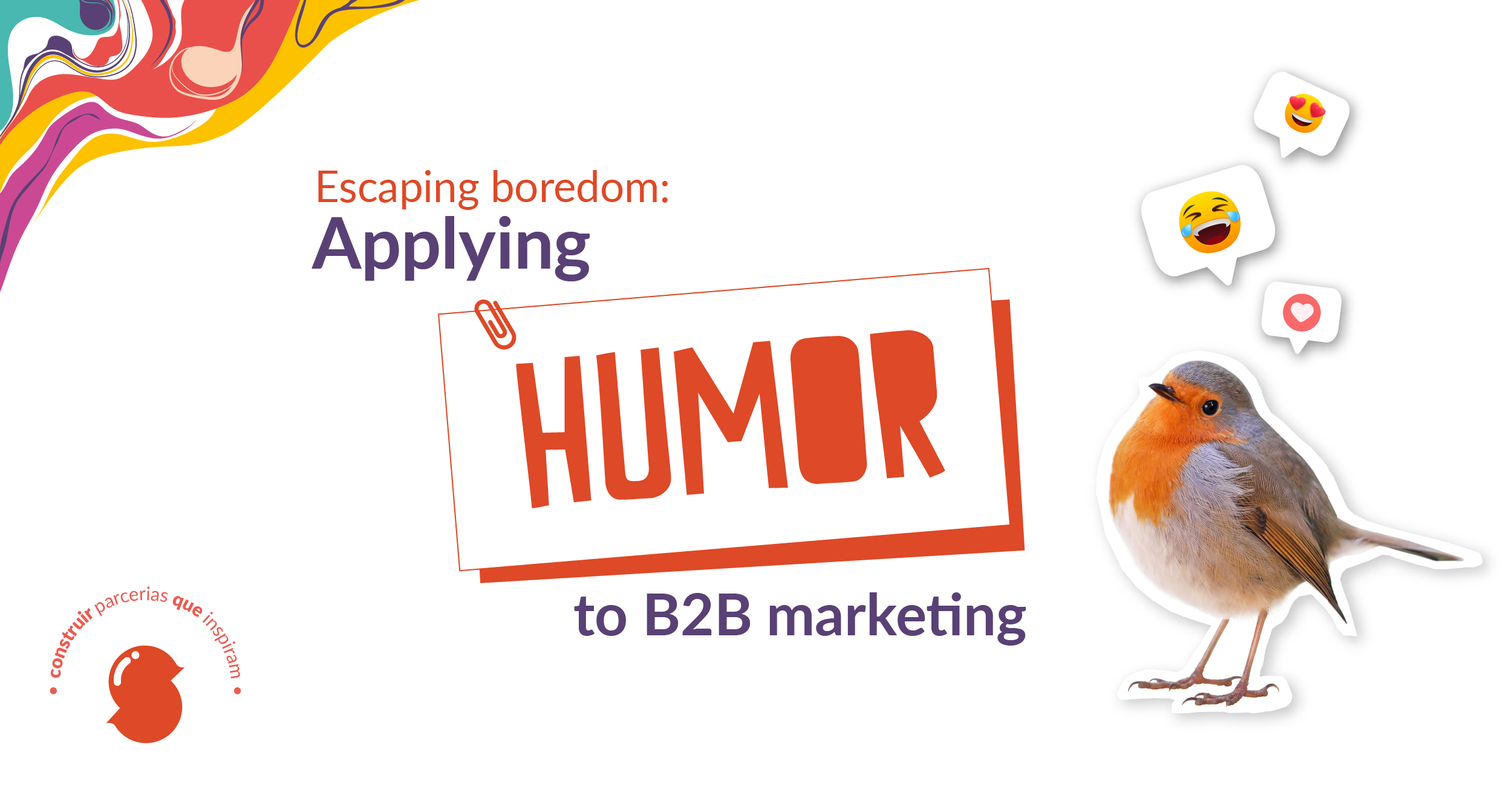
In the world of B2B marketing, where serious, highly rational graphics and business jargon used to reign supreme, digital native technology companies and start-ups are challenging the monotony with a bold and fun approach to their campaigns. In search of a more modern, creative, and agile image to communicate who they are (and connect with their customers and employees), they have applied humor to their campaigns.
Following this new trend in young and modern profiles, Agência Sabiá has been showing that it is possible to laugh while closing deals.
What is fun B2B marketing?
Fun B2B marketing refers to an innovative and relaxed approach to business-to-business (B2B) marketing. Instead of adopting the traditional seriousness associated with the corporate environment, companies are incorporating humorous and creative elements into their marketing strategies aimed at other companies.
In this approach, companies seek to stand out in relation to their competitors not only through their products or services, but also through the way they communicate their messages. This may involve using relaxed language, funny content, and memes in campaigns, in addition to participating in social media in a lighter way and even incorporating fun elements into sales presentations and meetings.

Pleasant and memorable advertisements test likability and are a useful predictor of customer and employee engagement, which reflects on well-being, building brand memories that make relationships more authentic, thus generating opportunities and sales growth.
How to find humor in creative processes?
Humor has gained prominence in B2B marketing due to the evolution of the market itself, as explained by Pedro Braga, executive director and founder of Agência Sabiá. “Previously recognized for its highly rational approach focused on technical results, the B2B market has undergone significant changes with increasing maturity and the adoption of broader solutions, including start-ups and native digital companies.”
According to Braga, these changes were driven by the need for differentiation in a competitive market and the transformation of B2B companies themselves, now represented by young and agile teams that seek to communicate in a modern and creative way.
Thus, humor emerged as an effective strategy to connect with this new customer profile and meet the demands of an increasingly mature and diverse market. When discussing the communication strategy, Braga highlights the importance of understanding and adapting to different target audiences. He emphasizes the need to use a variety of emotional tools, including humor, to convey messages effectively.
To imagine how this model works, let us analyze how two companies, served by Agência Sabiá, position themselves in a humorous way in different communication channels.
Compelling humor on social media with Tsoft
The bold approach of Tsoft, an information technology company, stands out in the B2B market for its fun and human perspective on social networks. Mariana Murias, director of the company’s services department, shares how the use of humor has become an act of empathy, bringing the brand closer to its audience and creating a positive atmosphere in digital interactions.
The company realized that humor is not only welcomed, but also valued by business customers, highlighting the importance of a bold, intelligent, and respectful approach in the business world.

Tsoft faced challenges when embarking on this new approach. However, with the guidance provided by Agência Sabiá, it managed to find the balance between creativity and professionalism. This cooperation has resulted in consistent and organic growth for T-Soft, with a stronger digital presence and a more solid brand image.
“We have observed that the increase in engagement generated by our relaxed approach translates into an improvement in conversions. A clear example is when some customers relate to this fun or “outside-the-box” approach, which results in more meaningful interactions: they share our publications, actively participate in the conversation and even give us ideas about how to expand it”, said Mariana Murias, director of the services department at Tsoft.
Humor integrated into the daily lives of teams at NTSec
NTSec, a Brazilian company from the information security segment, innovated in its marketing strategy by using memes and personalized stickers, developed by Agência Sabiá, as tools to generate engagement in the exchange of internal messages and break the austerity of the security area.
These pieces of creative content were carefully designed to incorporate the company’s employees, giving them a recognizable identity and establishing an emotional connection with the target audience in the company’s internal communication, which brought positive results, as observed by Eduardo Silva, marketing director at NTSec.
“We want to humanize communication, and we did so from the inside out, seeking to use more comfortable tools in our daily routine. The fact is that WhatsApp is the most agile and interactive channel, and today we use it for all communications. Stickers, memes, and the like are popular and often reinforce important messages that few would access on another channel, such as email, for example. In addition to making communication lighter, it inspires creation and interaction between regional offices, bringing together employees who are physically distant”, said Eduardo.
By integrating its own employees into humorous messages, the company was able to create a relaxed and authentic environment in its communications. This resulted in greater interaction and involvement on the part of employees, contributing to a more pleasant and productive environment, which ultimately reflects on customer service. This approach strengthened the sense of community and belonging in the company.
“The most important thing is to understand the language of your market and adapt it with common sense and wisdom. I believe we are on the right path, combining lightness, creativity, and intelligence”, he concludes.
The future of B2B relationships is fun
As B2B marketing embraces fun, experts predict a lighter, more engaging future for the business world. Companies that dare to be different, like Tsoft and NTSec, are reaping the benefits, creating more authentic relationships with their customers, and breaking down the barriers of formalism.
Looking at Latin America, Braga highlights the good-humored and fun nature of the Latin American people, suggesting that companies should incorporate these elements into their communication strategies.
He emphasizes that humor does not compromise the seriousness of the company’s value delivery, but rather the way this delivery is communicated. And he highlights the importance of humor in connecting with young audiences and attracting talent to fast-growing companies. “The Latin American people are people who have humor as part of their DNA. It is only natural for companies to also look for this,” he says.
If life is short, why not make business more fun? B2B marketing is proving that humor is not exclusive to B2C. It is time to laugh at the office and close big deals!
Why hire a communications agency specialized in Change Management?

An agency specialized in Change Management understands the complexities of organizational transformations and adapts communication using internal company resources, avoiding common pitfalls in this process and achieving positive results. It also customizes communication strategies for each project, differentiating itself from everyday internal communication.
How does Agência Sabiá work with Communication for Change Management?
Most consultancies offering Change Management services have communication skills, but they are not always prepared to direct this communication effectively to the company’s internal resources. This is an aspect in which the Agência Sabiá excels. Sabiá adopts a highly personalized approach, taking advantage of organizations’ internal communication tools and proposing integrated strategies for Change Management.
The channels, personas, target audience and frequency are adapted specifically to meet the needs of the project in transformation. This process differs from the usual internal communication flows, as it involves a change in the regular communication flow itself. In short, Agência Sabiá’s approach values personalization, efficiency and integration with the company’s internal operations, ensuring that communication is a critical component in the success of the transformation.
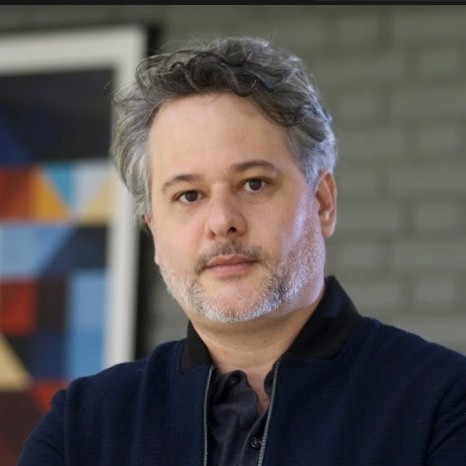
“People have the right to connect with a change or not. And, of course, this can determine whether or not they stay with a company that needs and must change. Fortunately, when a company follows a sensible path, most people will stay connected to it. The problem arises when a major transformation is poorly communicated and misunderstood. When this happens, people can feel pressured to accept and feign a connection that doesn’t exist, which tends to become an even bigger problem than explicit resistance. It is essential to promote an open dialog between employees, customers, partners and even clients. This is where Agência Sabiá plays a central role.”
Pedro Braga, Managing Director of Agência Sabiá
Who can use communication for Change Management?
Communication in Change Management can be applied by various organizations seeking to implement significant changes in their operating environment. This includes companies from multiple sectors, non-profit organizations, educational institutions, government institutions, health institutions, NGOs, civil society entities and research institutions, among others. Any organization that is going through a transformation process and wants to ensure a successful transition can benefit from Change Management communication.
Check out some of the Change Management projects carried out by Agência Sabiá below.
Cibra
Communication in Change Management was applied during the implementation of Salesforce in 2021, focusing on the Awareness and Desire stages using the ADKAR model. Good communication played a significant role in the successful adoption of the new sales tool, especially in the context of remote working. In general, projects that incorporate Change Management and effective communication show greater adherence to the released applications and an increase in engagement, with an estimated gain of 20% to 30% in the involvement of Key Users and end users, says Antônio Albérico de Souza Santos, IT Manager at Cibra.
Having a team dedicated to communication in change projects was an essential differentiator for Cibra, a company with a customer-centric focus and a startup approach. This is evident in projects such as the migration to SAP S4/Hana, where the presence of professionals specialized in Change Management and corporate communication is essential. The company also relied on Agência Sabiá as a consultancy to help with Change Management processes, efficiently implementing the ADKAR methodology, and avoiding delays that are common in projects that don’t have a team dedicated to these aspects.
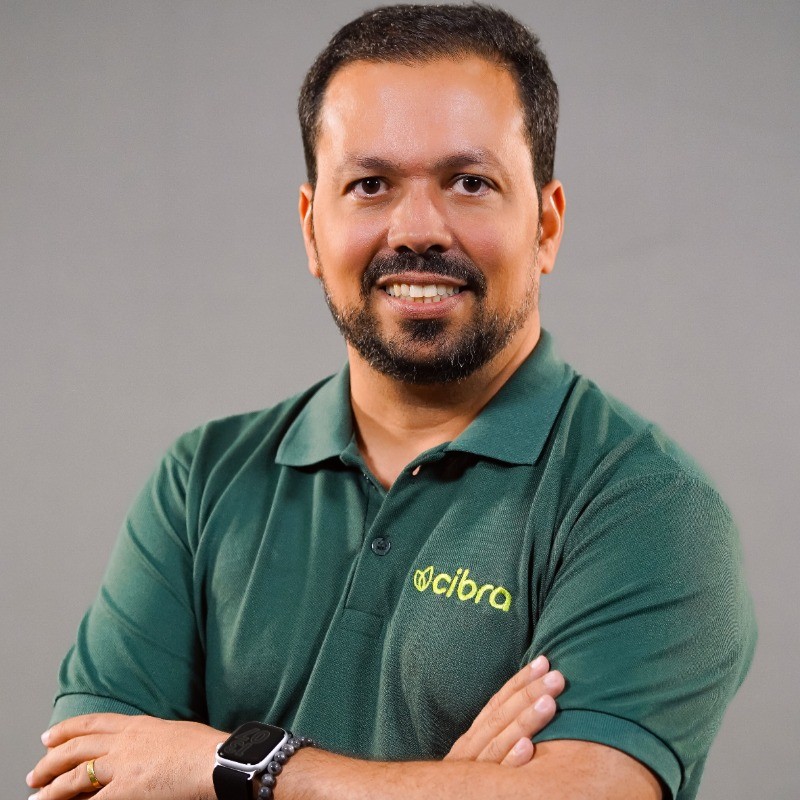
“Agência Sabiá conveys solidity and quality in every product delivered, adopting a highly collaborative approach that allows the client to make the necessary adjustments quickly and without compromising the quality of the deliverables. The meetings are clear; the methodology is well explained and precisely executed. The agency promotes an open and direct dialog about all the stages and processes, from start to finish. It is, therefore, a valid choice for processes that already have a change team and for those where you have no idea how to approach Change Management.”
Antônio Albérico de Souza Santos, IT Manager at Cibra
DSM
The former DSM, now DSM-Firmenich, applied communication to Change Management, which focused on safety and a restructuring of the safety department but also expanded to address Change Management related to the return of employees to the offices after the pandemic. Together with Agência Sabiá, the company designed a project to symbolize the arrival of the future called “NEWORK”, recognizing the importance of communicating changes by actively involving employees throughout the process.

In this project, Sabiá was involved in Change Management and communication for Change Management. “Generally, companies in the market are focused on one or the other. And this combo made the difference in the project. The results and feedback were very positive because the employees saw that DSM was connected, and to this day, we are reaping the rewards.”
Giseli Cristina de Pinha Daniel, HR Manager for Latin America DSM-Firmenich
Durante o projeto, foi realizada uma pesquisa abrangente, que incluiu entrevistas para entender as diferentes necessidades e percepções sobre a mudança, resultando em uma iniciativa muito mais participativa. No processo, a empresa identificou três principais personas: administrativo, vendas e plantas. Cada uma recebeu abordagens específicas para acomodar suas necessidades, como o trabalho híbrido, flexibilização de benefícios e bem-estar. Além disso, foram desenvolvidos uma marca, slogan, aplicativo e campanha para refletir a modernização e a descomplicação da nova maneira de trabalhar. O projeto foi considerado um sucesso, com alta aderência e absorção pelas equipes, demonstrando a eficácia de uma abordagem integrada à Gestão de Mudança.

When you apply communication beyond a tool and do it in an integrated way, thinking along with the change project, you can achieve a much more refined result. The change management work with Sabiá was linked to a global project but focused on regional aspects. And that was a differentiator.”
Andreia Fernandes, Internal Communications Manager for Latin America at DSM- Firmenich
Communication for Change Management: what it is and how to apply it and strategies
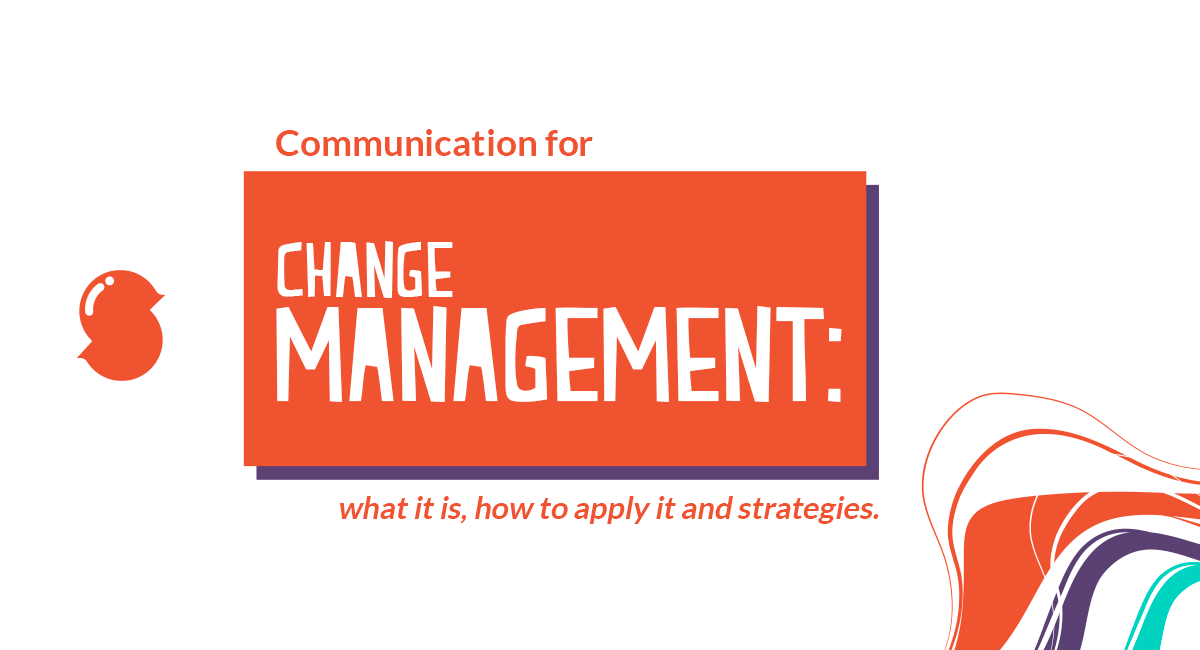
Change management is an essential element for the evolution and growth of any organization, and one of the most challenging tasks for leaders and managers. However, effective change management is not possible without strategic and comprehensive communication.
Whether a company is implementing a new technology, restructuring teams or adopting a new business strategy, the ability to successfully lead a transition is fundamental to long-term growth and results.
In this article, we will explore the fundamental role that communication plays in organizational Change Management and how it can be the key to success in times of transformation.
What is communication for Change Management?
Communication for Change Management is a strategic approach that involves planning, implementing and managing communication during organizational transformation processes. It aims to ensure that change-related messages are understood, accepted and internalized by all team members and stakeholders.
What are the benefits of communication for Change Management?
Communication in Change Management plays a creative and critical role in creating awareness of the need for change. When well-planned and applied within a Change Management plan, it motivates and encourages the active participation of the people involved. Open, transparent and inclusive communication during the Change Management process can strengthen the culture of trust and collaboration.
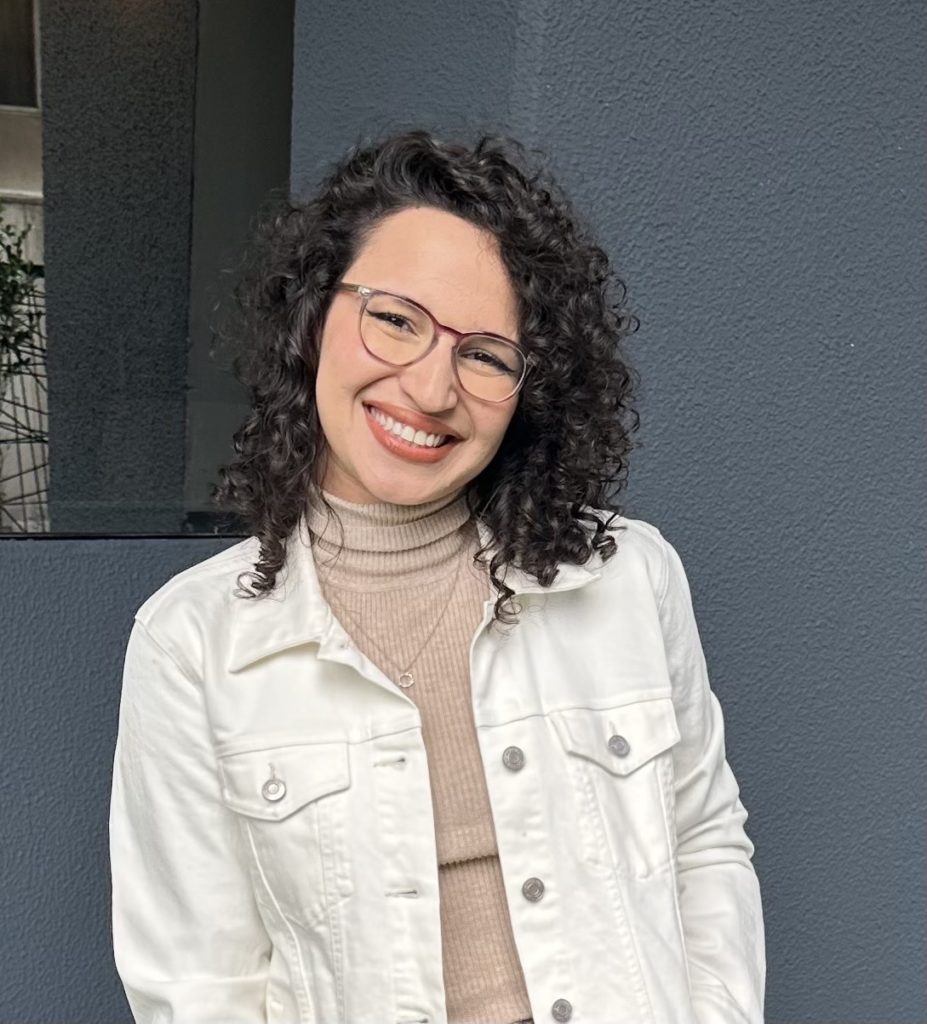
“Change often brings uncertainty, which can cause anxiety. A lack of understanding of expectations can lead to confusion and misunderstandings. Communication in Change Management provides clear guidelines on what is expected of each team member during the change process and helps to dispel uncertainty, increasing trust in the process. We can manage a change without focusing on communication. Still, people like to become part of the process, and communication helps with this, as we can integrate different audiences with different ways of communicating.”
Niedja Anjos, Head of Customer Service at Agência Sabiá
Communication in Change Management helps to collect information, opinions, evaluations or comments from those involved throughout the change process. This enables continuous adjustments and improvements to the change strategy. This way, concerns can be identified and addressed, reducing resistance and promoting a smoother transition.
Four benefits of communication for Change Management
1. Engagement and commitment
Effective communication involves team members right from the start, keeping them informed about the objectives of the change and the reasons behind it. This helps to create a sense of purpose and commitment, which are fundamental to the success of the transition.
2. Reducing resistance
Resistance to change is a common obstacle. Through transparent and honest communication, it is possible to address the concerns of individuals in the process, dispelling fears and creating an environment that is more receptive to change.
3. Clarity of expectations
a lack of understanding of expectations can lead to confusion and misunderstandings. Effective communication provides clear guidelines on what is expected of each team member during the change process.
4. Motivation and inspiration
communication should not be limited to facts and figures. It should also inspire and motivate the team, showing how the change can benefit the organization and the individuals involved.
Communication strategies for Change Management
For effective communication in Change Management, it is essential to follow well-defined steps to ensure the transformation is understood, accepted, internalized and successfully adopted.
Agência Sabiá has people certified by Prosci, which has as one of its central elements the ADKAR, a prevalent model in organizations, which covers the five essential stages of change: Awareness, Desire, Knowledge, Ability, Reinforcement.
The first step is the creation of awareness, where it is communicated that the change is about to happen. At this stage, people must understand what exactly is going to change. Next, desire is developed, emphasizing the benefits of change to motivate the team. The third step seeks to broaden knowledge, ensuring that everyone thoroughly understands what to do and the steps to follow on the journey of change, establishing trust.
The penultimate step is enablement, in which people receive training and resources to prepare for the future and use the necessary tools. Finally, the last stage is reinforcement, which occurs throughout the change process, providing ongoing support, communicating results and reinforcing the importance of transformation.

“We go through transformations all the time, at an ever-increasing pace. Communication comes in to increase the fluidity of the Change Management process. It’s a tool present in process surveys, communications, videos, recognitions, celebrations and gifts, or even in an off-site immersion. When we manage to bring people on board with the change the company wants to make, everyone is on the same page, engaged and on board. And when they go along, they do their best. To do this, you need to immerse yourself in the reality of the company and the people with empathy.”
Mariana Oliveira, specialist copywriter at Agência Sabiá
Six steps to successfully implement change
1. Research
Before starting any change process, it is essential to carry out a research study to understand the possible resistance that may arise. This involves identifying their location, whether in teams, departments or between individuals. Knowing the points of attention allows you to be prepared to address them creatively and effectively during the implementation of the change.
2. Plan
Based on the initial research, we develop a detailed communication plan. This includes setting clear goals, identifying key target audiences, determining the most appropriate communication channels and establishing a timeline. Planning is vital to ensuring that communication is organized and targeted.
3. Influencing
We involve the organization’s management and leadership from the outset. Leadership is vital in influencing and setting a positive example during change. They must be committed to the objectives of the transformation and be visible to support implementation.
4. Communicate/Generate knowledge
This is the execution phase of the communication plan. It is essential to clearly and consistently communicate the objectives of the change, the expected benefits, progress and any relevant information. Make sure you adapt the message to different audiences and various channels.
5. Reinforce knowledge
Communication should not be a one-off event but continuous throughout the change process. Reinforcing knowledge involves repeating key messages, providing regular updates and continuing to communicate with those involved about the changes and their implications. This helps maintain focus and commitment throughout the process.
6. Close the loop or start again
After implementing the change, evaluate the results and the impact of the communication. If the change is successful, it’s time to end the cycle and recognize the achievements. However, if there are persistent challenges or additional changes, the process may need to be restarted based on feedback and lessons learned.
Agência Sabiá announces association with BBN Global
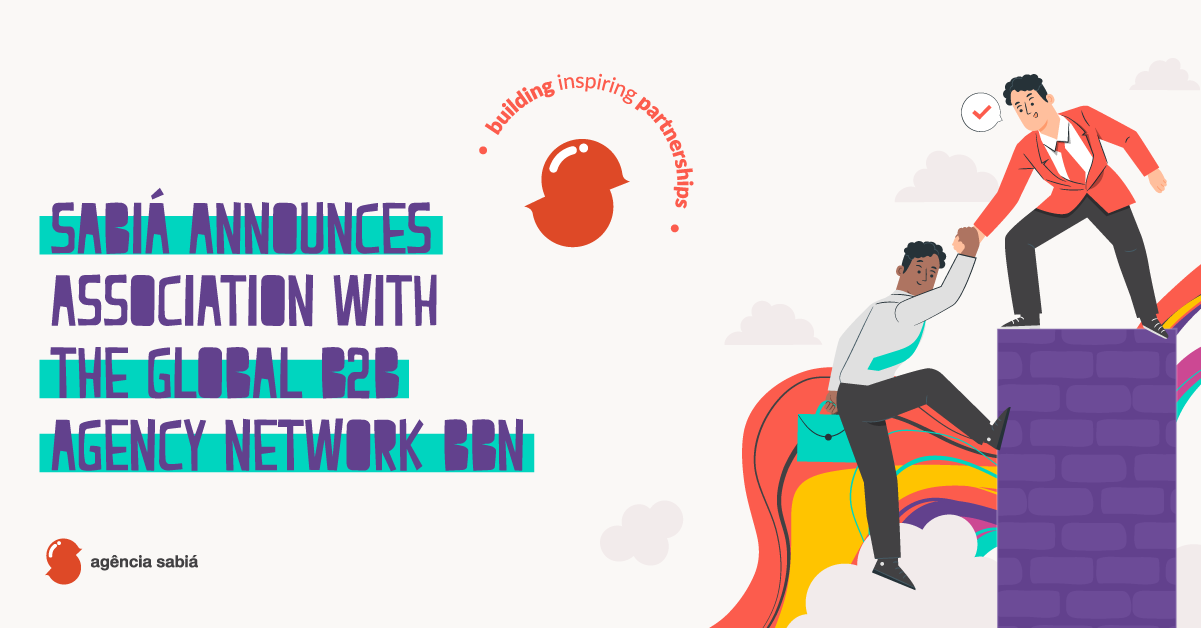
BBN is a global network of B2B agencies, bringing together more than 1200 communications and marketing experts in 29 countries.
Agência Sabiá announced this week its association with BBN, a global network of B2B marketing agencies, which was born in Europe but currently reaches more than half of the countries in North, Central and South America. BBN’s partners have more than 500 customers from 23 different B2B sectors, generating more than US$185 million in global revenue.
According to Pedro Braga, founder and executive director of Agência Sabiá, the partnership with BBN is part of Sabiá’s growth acceleration strategy, through collaboration between partners to increasingly leverage the technical competence and service capacity of the Agency’s team, in addition to access to references and global networking on all areas of Sabiá’s operations.
“Our motto at Sabiá is to Build Partnerships that Inspire. So, we know the importance of quality connections with our customers, suppliers and partners. In this sense, choosing BBN as an international network for us to participate places us in an even broader collaborative group, which shares our values and opens up possibilities for expanding our business and supporting our clients’ growth”, evaluates Braga.
In its Growth Latam business axis, Sabiá positions itself as a strategic partner for the marketing area of national and international clients in Brazil and Latin America. In this highly specialized axis for B2B companies in the technology sector, the Agency operates in digital activations, campaigns, lead generation and relationship events focusing on regional growth. In the Culture and Engagement Acceleration axis, Sabiá serves large companies in complex change processes and works in communications for employee engagement and awareness, promoting a joint evolution with the organization.
BBN is currently the world’s leading global network of B2B communications agencies. It has a history of more than three decades of collaboration, in which agencies from around the world have worked together to develop and use a highly effective, uniform and structured approach to brand strategy, public relations, marketing and creative services to ensure award-winning results for customers all over the world.
“We are thrilled to integrate Sabiá into our network. Sabiá has earned a great reputation and an impressive list of satisfied customers. The addition of Sabiá to our network reinforces BBN’s presence in the Americas, especially in South America, and helps BBN to solidify its capabilities in marketing and corporate communications”, says Annette Poyser, executive director of BBN.
To learn more about BBN, visit: bbn-international.com
To learn more about Sabiá, visit: https://agenciasabia.com.br/
The Sabiá way of organizing events aligned with the client’s business objectives
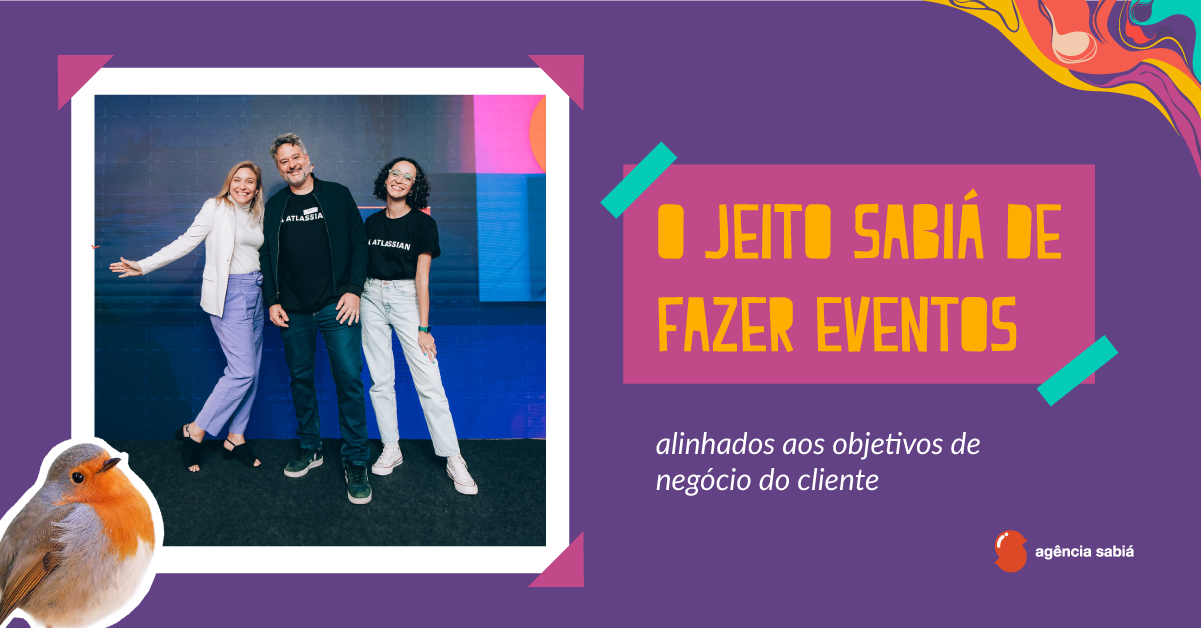
Discover Agência Sabiá’s expertise in holding events in the B2B market with a focus on technology, attracting decision-making and highly specialized audience, not only in Brazil, but in neighboring countries in Latin America
Events are strategic tools for companies. It is at these meetings, which can be held in the most varied formats, that companies and professionals connect, expand relationships, learn about products and services and drive new opportunities. But, how can you hold an event that promotes relevant results and makes the investment worth it?
Sabiá, an agency with a strong presence in the technology sector, has stood out in the market for going beyond ready-made models and offering its clients events fully aligned with business objectives and capable of promoting an effective connection with the target audience to generate relevant results.
With expertise in structuring an event from end to end, Sabiá is responsible for all the processes that involve the organization of an initiative like this: the evaluation of objectives, the design of the experience, the public attraction strategy, the relationship with speakers and partners, in addition to post-event, such as data and information evaluation and support for sales teams.
Most of the projects delivered by Sabiá are aimed at B2B companies with a focus on technology – mainly software and SaaS – that are looking for complete solutions for holding events in Brazil or in neighboring countries in Latin America.
Among the 2023 events, “ITSM Transformation”, aimed at customers and partners of the Australian software multinational Atlassian, was held in two editions: Brazil and Mexico. The events were attended by more than 200 people and were strategically planned so that they were aligned with Atlassian’s business objectives. In the edition held in Brazil alone, more than 300 leads were generated. In Mexico, that number reached almost 150.

Operations Director Vanessa Sensato, Executive Director Pedro Braga and Account Manager Aline Mariano, respectively, at the ITSM Brazil Transformation event.
André Palma, partner manager at Atlassian, states that to hold events at the company, it is essential to understand the expected return on investment and, therefore, define strategies. For this reason, according to him, Sabiá has become an important partner, especially due to its extensive knowledge in the area.
“Sabiá stands out for having specific knowledge about the technology area, being able to share insights and experiences that have or have not worked in other events, offering us ideas out of the box”, says the executive.
With many years dedicated to the area, the highly specialized technology market has become Sabiá’s expertise, leading to a clear understanding of what the public in this sector expects in these meetings, from format to content and possible connections.
“We know the market and the profile of technology professionals, so we understand how they connect. This way, we can suggest to the client not only communication actions but the entire structure of the event, supporting this company locally”, explains Pedro Braga, executive director of Sabiá.
In addition to understanding the market, the ability to connect to the company’s business objectives and, from that, think about how to measure whether the goals are being achieved is another skill that Agência Sabiá highly values among its clients. In the first half of 2023, for example, Sabiá was the agency responsible for the entire infrastructure and experiences of the “Future Stack”, an event by the technology multinational New Relic, which took place in São Paulo. With a large part of the team located abroad, Sabiá was the main point of contact in Brazil for the entire organization of the event.
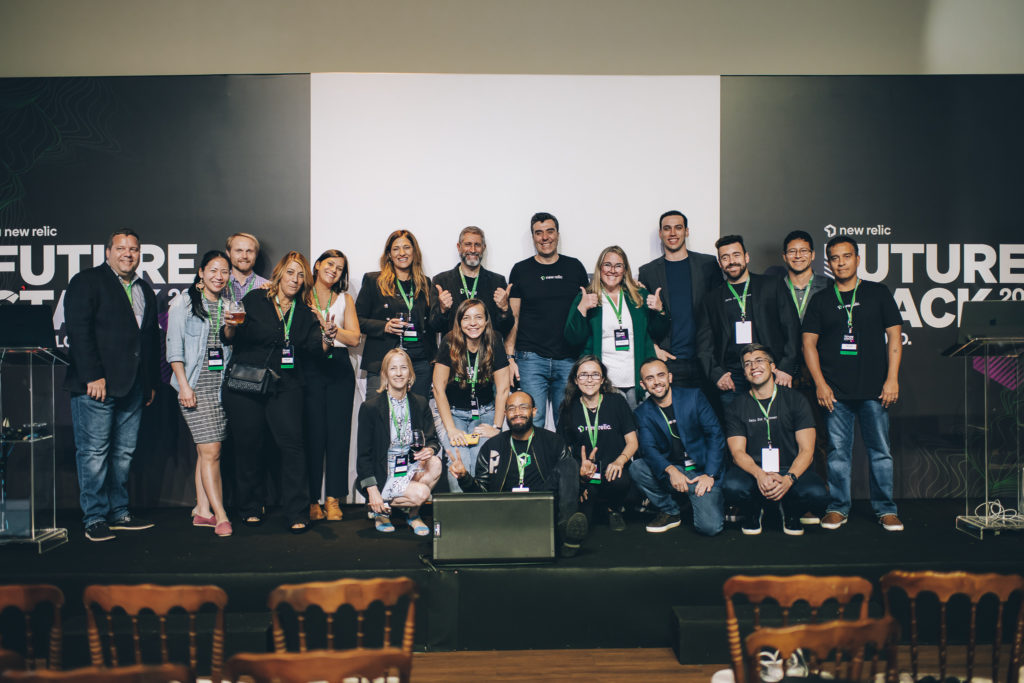
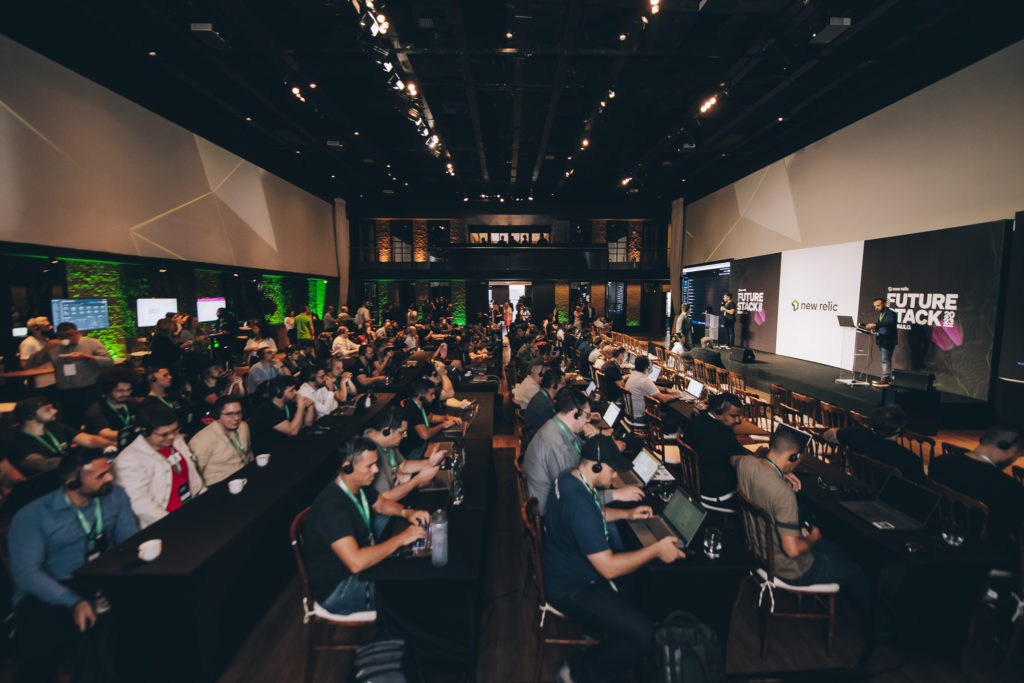
Jennifer Merkle, senior director of marketing for Americas and ABM at New Relic, based in California, says that when she starts designing an event, she immediately thinks about how to measure the business objectives to be achieved, whether they be expanding the sales funnel, gain new leads or even increase the number of people using the tool within companies that are already customers. “Before starting the event, it is important to think about what you will measure. This will guide us in structuring the event as a whole”, she comments.
Merkle assesses that although there is an appetite for in-person events post-pandemic, marketing professionals must consider that many events compete in the same initiatives. “We have to give the client a reason to come to our event, which is why we try to create unique events”, commented the executive.
Content curation and contact with customers and partners
 Connections between partners, sponsors and suppliers are also within Sabiá’s scope of action. For example, Atlassian events produced by Sabiá this year focused on giving visibility to the multinational’s partners in Brazil and Mexico. To this end, these partners presented success stories about the multinational’s solutions and how they resulted in relevant changes for their clients, generally big names in the industry.
Connections between partners, sponsors and suppliers are also within Sabiá’s scope of action. For example, Atlassian events produced by Sabiá this year focused on giving visibility to the multinational’s partners in Brazil and Mexico. To this end, these partners presented success stories about the multinational’s solutions and how they resulted in relevant changes for their clients, generally big names in the industry.
For the presentations to impact the public, the Sabiá team curated the content, supporting partners in the exhibits and extracting the best cases to be presented. The materials were also adapted for a non-specialist audience. The proposal, according to Sabiá’s account assistant, Aline Mariano, was to make the presentations also accessible to Human Resources or Marketing teams, for example, who do not have technical knowledge of the solutions but who often have a decision-making role in evaluating the corporate tools and seek to learn how they can be applied in their departments and bring improvements to their daily lives.
“These types of content are quite specialized, but we have a highly qualified team that can make the materials more accessible for other professionals to understand. We worked to connect with Atlassian partners to support them in these presentations and extract the best cases to be shared”, explains Mariano.
Communication trousseau
The event landing page, production of communication materials for activation on Linkedin, and customer and partner channels are also essential for organizing an event. The “promotions trousseau”, with variations of pieces so that each partner can use them in the most efficient channels, is a powerful tool in assertively attracting the desired target audience at the event.
“We adapted the pieces for each partner to attract the event’s target audience more assertively. And the result has been very positive, with the reach of an extremely qualified audience”, stated Mariano.